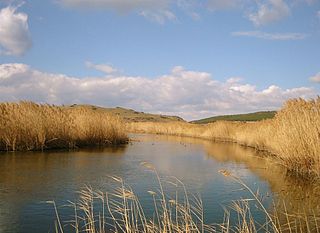
Heliopolis was a major city of ancient Egypt. It was the capital of the 13th or Heliopolite Nome of Lower Egypt and a major religious centre. It is now located in Ayn Shams, a northeastern suburb of Cairo.

Leontopolis was an ancient Egyptian city located in the Nile Delta, Lower Egypt. It served as a provincial capital and Metropolitan Archbishopric, which remains a Latin Catholic titular see. The archaeological site and settlement are known today as Kafr Al Muqdam.

Pelusium was an important city in the eastern extremes of Egypt's Nile Delta, 30 km to the southeast of the modern Port Said. It became a Roman provincial capital and Metropolitan archbishopric and remained a multiple Catholic titular see.
Corfinium was a city in ancient Italy, on the eastern side of the Apennines, due east of Rome, near modern Corfinio, in the province of L'Aquila.

Thmuis was a city in Lower Egypt, located on the canal east of the Nile, between its Tanitic and Mendesian branches. Its ruins are near the modern city of Timayy al-Imdid.

Busiris was an ancient city in Lower Egypt, located at the present-day Abu Sir Bana.
Harpasa was a city and bishopric in ancient Caria in Roman Asia Minor, which only remains a Latin Catholic titular see.
Augustamnica (Latin) or Augoustamnike (Greek) was a Roman province of Egypt created during the 5th century and was part of the Diocese of Oriens first and then of the Diocese of Egypt, until the Muslim conquest of Egypt in the 640s.

Babylon Fortress is an ancient fortress in the Nile Delta, located in the area known today as Coptic Cairo. It is situated in the former area of the Heliopolite Nome, upon the east bank of the Nile, at latitude 30°N, near the commencement of the Pharaonic Canal, from the Nile to the Red Sea.

Myrina was one of the Aeolian cities on the western coast of Mysia, about 40 stadia to the southwest of Gryneion. The former bishopric is now a Latin Catholic titular see.
Thennesus was a town in the Roman province of Augustamnica Prima. It was on the Tanitic branch of the Nile. It is today called Tell-Tenis, Tell-Tannis or Qôm-Tannis, at the extremity of an island in Lake Menzaleh, near the Suez Canal. There are remains, ruins and tombs, of the Roman era.
Casius was a residential episcopal see in the Roman province of Augustamnica Prima in Lower Egypt, and is now a titular see of the Catholic Church.
Hephæstus was a town in Roman Egypt, in the province of Augustamnica Prima, the eastern part of the Nile Delta.
Phacusa was a city in the late Roman province of Augustamnica Prima. It served as a bishopric that was a suffragan of Pelusium, the metropolitan see of that province.

Abonoteichos, later Ionopolis, was an ancient city in Asia Minor, on the site of modern İnebolu and remains a Latin Catholic titular see.
Aphnaeum was an ancient city and former bishopric in Egypt. It is currently a Latin Catholic titular see. Its location is believed to be near the ruins of modern Tell-Defenneh.
Gera(s) was an ancient city and former bishopric in Roman Egypt and remains a Latin Catholic titular see.
Tyriaeum or Tyriaion, also spelled Tyraion, was a Roman and Byzantine era civitas in the Roman Province of Pisidia, located ten parasangs from Iconium It was mentioned by Xenophon, and Pliny and Strabo tell us it was between Philomelium (Akshehr) and Laodicea Combusta. It is tentatively identified with ruins near modern Teke Kozağaçi (Turkey) on the road from Antalya to Denizli or near modern Ilgın.

The bishop of Tanis was the head of the Christian church in the ancient Egyptian city of Tanis. Although it is no longer a residential bishopric, it has been a titular bishopric in the Roman Catholic Church since the Middle Ages.






